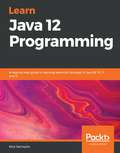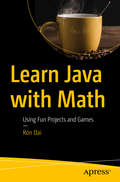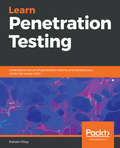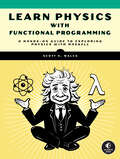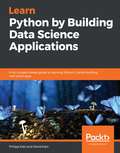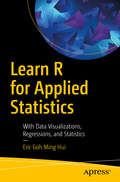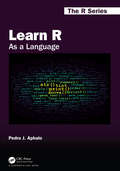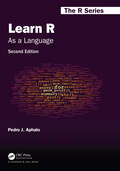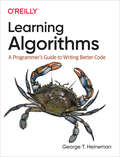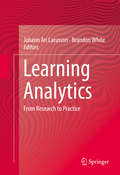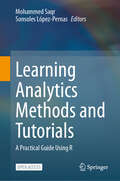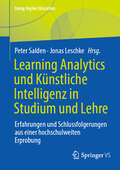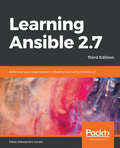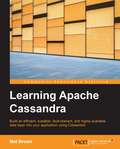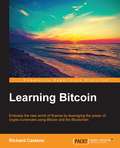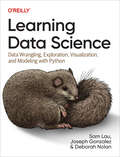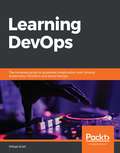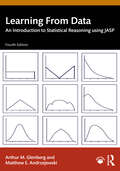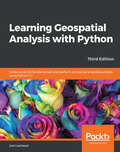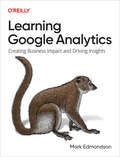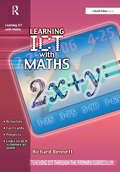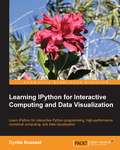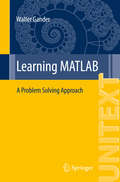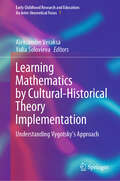- Table View
- List View
Learn Java 12 Programming: A step-by-step guide to learning essential concepts in Java SE 10, 11, and 12
by Nick SamoylovA comprehensive guide to get started with Java and gain insights into major concepts such as object-oriented, functional, and reactive programmingKey FeaturesStrengthen your knowledge of important programming concepts and the latest features in JavaExplore core programming topics including GUI programming, concurrency, and error handlingLearn the idioms and best practices for writing high-quality Java codeBook DescriptionJava is one of the preferred languages among developers, used in everything right from smartphones, and game consoles to even supercomputers, and its new features simply add to the richness of the language. This book on Java programming begins by helping you learn how to install the Java Development Kit. You will then focus on understanding object-oriented programming (OOP), with exclusive insights into concepts like abstraction, encapsulation, inheritance, and polymorphism, which will help you when programming for real-world apps. Next, you’ll cover fundamental programming structures of Java such as data structures and algorithms that will serve as the building blocks for your apps. You will also delve into core programming topics that will assist you with error handling, debugging, and testing your apps. As you progress, you’ll move on to advanced topics such as Java libraries, database management, and network programming, which will hone your skills in building professional-grade apps.Further on, you’ll understand how to create a graphic user interface using JavaFX and learn to build scalable apps by taking advantage of reactive and functional programming.By the end of this book, you’ll not only be well versed with Java 10, 11, and 12, but also gain a perspective into the future of this language and software development in general.What you will learnLearn and apply object-oriented principlesGain insights into data structures and understand how they are used in JavaExplore multithreaded, asynchronous, functional, and reactive programmingAdd a user-friendly graphic interface to your applicationFind out what streams are and how they can help in data processingDiscover the importance of microservices and use them to make your apps robust and scalableExplore Java design patterns and best practices to solve everyday problemsLearn techniques and idioms for writing high-quality Java codeWho this book is forStudents, software developers, or anyone looking to learn new skills or even a language will find this book useful. Although this book is for beginners, professional programmers can benefit from it too. Previous knowledge of Java or any programming language is not required.
Learn Java with Math: Using Fun Projects and Games
by Ron DaiThere are many good Java programming books on the market, but it's not easy to find one fit for a beginner. This book simplifies the complexity of Java programming and guides you through the journey to effectively work under the hood. You'll start with the fundamentals of Java programming and review how it integrates with basic mathematical concepts through many practical examples. You'll witness firsthand how Java can be a powerful tool or framework in your experimentation work.Learn Java with Math reveals how a strong math foundation is key to learning programming design. Using this as your motivation, you'll be programming in Java in no time.What You'll LearnExplore Java basicsProgram with Java using fun math-inspired examplesWork with Java variables and algorithmsReview I/O, loops, and control structuresUse projects such as the Wright brothers coin flip gameWho This Book Is ForThose new to programming and Java but have some background in mathematics and are at least comfortable with using a computer.
Learn Penetration Testing: Understand the art of penetration testing and develop your white hat hacker skills
by Rishalin PillayGet up to speed with various penetration testing techniques and resolve security threats of varying complexityKey FeaturesEnhance your penetration testing skills to tackle security threatsLearn to gather information, find vulnerabilities, and exploit enterprise defensesNavigate secured systems with the most up-to-date version of Kali Linux (2019.1) and Metasploit (5.0.0)Book DescriptionSending information via the internet is not entirely private, as evidenced by the rise in hacking, malware attacks, and security threats. With the help of this book, you'll learn crucial penetration testing techniques to help you evaluate enterprise defenses.You'll start by understanding each stage of pentesting and deploying target virtual machines, including Linux and Windows. Next, the book will guide you through performing intermediate penetration testing in a controlled environment. With the help of practical use cases, you'll also be able to implement your learning in real-world scenarios. By studying everything from setting up your lab, information gathering and password attacks, through to social engineering and post exploitation, you'll be able to successfully overcome security threats. The book will even help you leverage the best tools, such as Kali Linux, Metasploit, Burp Suite, and other open source pentesting tools to perform these techniques. Toward the later chapters, you'll focus on best practices to quickly resolve security threats.By the end of this book, you'll be well versed with various penetration testing techniques so as to be able to tackle security threats effectivelyWhat you will learnPerform entry-level penetration tests by learning various concepts and techniquesUnderstand both common and not-so-common vulnerabilities from an attacker's perspectiveGet familiar with intermediate attack methods that can be used in real-world scenariosUnderstand how vulnerabilities are created by developers and how to fix some of them at source code levelBecome well versed with basic tools for ethical hacking purposesExploit known vulnerable services with tools such as MetasploitWho this book is forIf you’re just getting started with penetration testing and want to explore various security domains, this book is for you. Security professionals, network engineers, and amateur ethical hackers will also find this book useful. Prior knowledge of penetration testing and ethical hacking is not necessary.
Learn Physics with Functional Programming: A Hands-on Guide to Exploring Physics with Haskell
by Scott N. WalckDeepen your understanding of physics by learning to use the Haskell functional programming language.Learn Physics with Functional Programming is your key to unlocking the mysteries of theoretical physics by coding the underlying math in Haskell.You&’ll use Haskell&’s type system to check that your code makes sense as you deepen your understanding of Newtonian mechanics and electromagnetic theory, including how to describe and calculate electric and magnetic fields.As you work your way through the book&’s numerous examples and exercises, you&’ll learn how to:Encode vectors, derivatives, integrals, scalar fields, vector fields, and differential equationsExpress fundamental physical principles using the logic of Haskell&’s type system to clarify Newton&’s second law, Coulomb&’s law, the Biot-Savart law, and the Maxwell equationsUse higher-order functions to express numerical integration and approximation methods, such as the Euler method and the finite-difference time-domain (FDTD) methodCreate graphs, models, and animations of physical scenarios like colliding billiard balls, waves in a guitar string, and a proton in a magnetic fieldWhether you&’re using this book as a core textbook for a computational physics course or for self-study, Learn Physics with Functional Programming will teach you how to use the power of functional programming to explore the beautiful ideas of theoretical physics.
Learn Python by Building Data Science Applications: A fun, project-based guide to learning Python 3 while building real-world apps
by David Katz Philipp KatsUnderstand the constructs of the Python programming language and use them to build data science projects Key Features Learn the basics of developing applications with Python and deploy your first data application Take your first steps in Python programming by understanding and using data structures, variables, and loops Delve into Jupyter, NumPy, Pandas, SciPy, and sklearn to explore the data science ecosystem in Python Book Description Python is the most widely used programming language for building data science applications. Complete with step-by-step instructions, this book contains easy-to-follow tutorials to help you learn Python and develop real-world data science projects. The “secret sauce” of the book is its curated list of topics and solutions, put together using a range of real-world projects, covering initial data collection, data analysis, and production. This Python book starts by taking you through the basics of programming, right from variables and data types to classes and functions. You'll learn how to write idiomatic code and test and debug it, and discover how you can create packages or use the range of built-in ones. You'll also be introduced to the extensive ecosystem of Python data science packages, including NumPy, Pandas, scikit-learn, Altair, and Datashader. Furthermore, you'll be able to perform data analysis, train models, and interpret and communicate the results. Finally, you'll get to grips with structuring and scheduling scripts using Luigi and sharing your machine learning models with the world as a microservice. By the end of the book, you'll have learned not only how to implement Python in data science projects, but also how to maintain and design them to meet high programming standards. What you will learn Code in Python using Jupyter and VS Code Explore the basics of coding – loops, variables, functions, and classes Deploy continuous integration with Git, Bash, and DVC Get to grips with Pandas, NumPy, and scikit-learn Perform data visualization with Matplotlib, Altair, and Datashader Create a package out of your code using poetry and test it with PyTest Make your machine learning model accessible to anyone with the web API Who this book is for If you want to learn Python or data science in a fun and engaging way, this book is for you. You'll also find this book useful if you're a high school student, researcher, analyst, or anyone with little or no coding experience with an interest in the subject and courage to learn, fail, and learn from failing. A basic understanding of how computers work will be useful.
Learn R for Applied Statistics: With Data Visualizations, Regressions, and Statistics
by Eric Goh HuiGain the R programming language fundamentals for doing the applied statistics useful for data exploration and analysis in data science and data mining. This book covers topics ranging from R syntax basics, descriptive statistics, and data visualizations to inferential statistics and regressions. After learning R’s syntax, you will work through data visualizations such as histograms and boxplot charting, descriptive statistics, and inferential statistics such as t-test, chi-square test, ANOVA, non-parametric test, and linear regressions. Learn R for Applied Statistics is a timely skills-migration book that equips you with the R programming fundamentals and introduces you to applied statistics for data explorations. What You Will LearnDiscover R, statistics, data science, data mining, and big dataMaster the fundamentals of R programming, including variables and arithmetic, vectors, lists, data frames, conditional statements, loops, and functionsWork with descriptive statistics Create data visualizations, including bar charts, line charts, scatter plots, boxplots, histograms, and scatterplotsUse inferential statistics including t-tests, chi-square tests, ANOVA, non-parametric tests, linear regressions, and multiple linear regressionsWho This Book Is ForThose who are interested in data science, in particular data exploration using applied statistics, and the use of R programming for data visualizations.
Learn R: As a Language (Chapman & Hall/CRC The R Series)
by Pedro J. AphaloLearning a computer language like R can be either frustrating, fun, or boring. Having fun requires challenges that wake up the learner’s curiosity but also provide an emotional reward on overcoming them. This book is designed so that it includes smaller and bigger challenges, in what I call playgrounds, in the hope that all readers will enjoy their path to R fluency. Fluency in the use of a language is a skill that is acquired through practice and exploration. Although rarely mentioned separately, fluency in a computer programming language involves both writing and reading. The parallels between natural and computer languages are many, but differences are also important. For students and professionals in the biological sciences, humanities, and many applied fields, recognizing the parallels between R and natural languages should help them feel at home with R. The approach I use is similar to that of a travel guide, encouraging exploration and describing the available alternatives and how to reach them. The intention is to guide the reader through the R landscape of 2020 and beyond. Features R as it is currently used Few prescriptive rules—mostly the author’s preferences together with alternatives Explanation of the R grammar emphasizing the "R way of doing things" Tutoring for "programming in the small" using scripts The grammar of graphics and the grammar of data described as grammars Examples of data exchange between R and the foreign world using common file formats Coaching for becoming an independent R user, capable of both writing original code and solving future challenges What makes this book different from others: Tries to break the ice and help readers from all disciplines feel at home with R Does not make assumptions about what the reader will use R for Attempts to do only one thing well: guide readers into becoming fluent in the R language Pedro J. Aphalo is a PhD graduate from the University of Edinburgh, and is currently a lecturer at the University of Helsinki. A plant biologist and agriculture scientist with a passion for data, electronics, computers, and photography, in addition to plants, Dr. Aphalo has been a user of R for 25 years. He first organized an R course for MSc students 18 years ago, and is the author of 13 R packages currently in CRAN.
Learn R: As a Language (Chapman & Hall/CRC The R Series)
by Pedro J. AphaloLearning a computer language like R can be either frustrating, fun or boring. Having fun requires challenges that wake up the learner’s curiosity but also provide an emotional reward for overcoming them. The book is designed so that it includes smaller and bigger challenges, in what I call playgrounds, in the hope that all readers will enjoy their path to R fluency. Fluency in the use of a language is a skill that is acquired through practice and exploration. For students and professionals in the biological sciences, humanities and many applied fields, recognizing the parallels between R and natural languages should help them feel at home with R. The approach I use is similar to that of a travel guide, encouraging exploration and describing the available alternatives and how to reach them. The intention is to guide the reader through the R landscape of 2024 and beyond.What is new in the second edition? Text expanded by more than 25% to include additional R features and gentler and more detailed explanations Contains 24 new diagrams and flowcharts, seven new tables, and revised text and code examples for clarity All three indexes were expanded, and answers to 28 frequently asked questions added What will you find in this book? Programming concepts explained as they apply to current R Emphasis on the role of abstractions in programming Few prescriptive rules—mostly the author’s preferences together with alternatives Presentation of the R language emphasizing the “R way of doing things” Tutoring for “programming in the small” using scripts for data analysis Explanation of the differences between R proper and extensions for data wrangling The grammar of graphics is described as a language for the construction of data visualisations Examples of data exchange between R and the foreign world using common file formats Coaching to become an independent R user, capable of writing original scripts and solving future challenges
Learning Algorithms: A Programmer's Guide to Writing Better Code
by George HeinemanWhen it comes to writing efficient code, every software professional needs to have an effective working knowledge of algorithms. In this practical book, author George Heineman (Algorithms in a Nutshell) provides concise and informative descriptions of key algorithms that improve coding. Software developers, testers, and maintainers will discover how algorithms solve computational problems creatively.Each chapter builds on earlier chapters through eye-catching visuals and a steady rollout of essential concepts, including an algorithm analysis to classify the performance of every algorithm presented in the book. At the end of each chapter, you'll get to apply what you've learned to a novel challenge problem -- simulating the experience you might find in a technical code interview.With this book, you will:Examine fundamental algorithms central to computer science and software engineeringLearn common strategies for efficient problem solving -- such as divide and conquer, dynamic programming, and greedy approachesAnalyze code to evaluate time complexity using big O notationUse existing Python libraries and data structures to solve problems using algorithmsUnderstand the main steps of important algorithms
Learning Analytics
by Johann Ari Larusson Brandon WhiteIn education today, technology alone doesn't always lead to immediate success for students or institutions. In order to gauge the efficacy of educational technology, we need ways to measure the efficacy of educational practices in their own right. Through a better understanding of how learning takes place, we may work toward establishing best practices for students, educators, and institutions. These goals can be accomplished with learning analytics. Learning Analytics: From Research to Practice updates this emerging field with the latest in theories, findings, strategies, and tools from across education and technological disciplines. Guiding readers through preparation, design, and examples of implementation, this pioneering reference clarifies LA methods as not mere data collection but sophisticated, systems-based analysis with practical applicability inside the classroom and in the larger world. Case studies illustrate applications of LA throughout academic settings (e. g. , intervention, advisement, technology design), and their resulting impact on pedagogy and learning. The goal is to bring greater efficiency and deeper engagement to individual students, learning communities, and educators, as chapters show diverse uses of learning analytics to: Enhance student and faculty performance. Improve student understanding of course material. Assess and attend to the needs of struggling learners. Improve accuracy in grading. Allow instructors to assess and develop their own strengths. Encourage more efficient use of resources at the institutional level. Researchers and practitioners in educational technology, IT, and the learning sciences will hail the information in Learning Analytics: From Research to Practice as a springboard to new levels of student, instructor, and institutional success.
Learning Analytics Methods and Tutorials: A Practical Guide Using R
by Sonsoles López-Pernas Mohammed SaqrThis open access comprehensive methodological book offers a much-needed answer to the lack of resources and methodological guidance in learning analytics, which has been a problem ever since the field started. The book covers all important quantitative topics in education at large as well as the latest in learning analytics and education data mining. The book also goes deeper into advanced methods that are at the forefront of novel methodological innovations. Authors of the book include world-renowned learning analytics researchers, R package developers, and methodological experts from diverse fields offering an unprecedented interdisciplinary reference on novel topics that is hard to find elsewhere.The book starts with the basics of R as a programming language, the basics of data cleaning, data manipulation, statistics, and analytics. In doing so, the book is suitable for newcomers as they can find an easy entry to the field, as well as being comprehensive of all the major methodologies. For every method, the corresponding chapter starts with the basics, explains the main concepts, and reviews examples from the literature. Every chapter has a detailed explanation of the essential techniques and basic functions combined with code and a full tutorial of the analysis with open-access real-life data. A total of 22 chapters are included in the book covering a wide range of methods such as predictive learning analytics, network analysis, temporal networks, epistemic networks, sequence analysis, process mining, factor analysis, structural topic modeling, clustering, longitudinal analysis, and Markov models. What is really unique about the book is that researchers can perform the most advanced analysis with the included code using the step-by-step tutorial and the included data without the need for any extra resources.This is an open access book.
Learning Analytics und Künstliche Intelligenz in Studium und Lehre: Erfahrungen und Schlussfolgerungen aus einer hochschulweiten Erprobung (Doing Higher Education)
by Peter Salden Jonas LeschkeIn dem Sammelband werden die Ergebnisse aus dem Projekt „KI:edu.nrw - Didaktik, Ethik und Technik von Learning Analytics und KI in der Hochschulbildung“ im Zeitraum 2020-2023 vorgestellt. Ziel des Projekts war es, sowohl an der im Schwerpunkt geförderten Ruhr-Universität Bochum als auch an der partnerschaftlich verbundenen RWTH Aachen exemplarisch zu erarbeiten, wie Regeln, Konzepte, Prozesse und Technik für den Einsatz von Learning Analytics und KI in Studium und Lehre ausgestaltet werden können. Die Besonderheit: Alle lehrbezogenen Akteurinnen und Akteure wurden in einem umfassenden Ansatz einbezogen, um zu verstehen, wie Hochschulen sich als Gesamtorganisationen auf die kommenden Herausforderungen in diesem Bereich einstellen müssen. Der Band zeigt damit Wege in eine zukünftige Hochschulwelt, die nicht mehr in allzu weiter Ferne liegt.
Learning Ansible 2.7: Automate your organization's infrastructure using Ansible 2.7, 3rd Edition
by Fabio Alessandro LocatiUse Ansible to configure your systems, deploy software, and orchestrate advanced IT tasksKey FeaturesGet familiar with the fundamentals of Ansible 2.7Understand how to use Ansible Tower to scale your IT automationGain insights into how to develop and test Ansible playbooks Book DescriptionAnsible is an open source automation platform that assists organizations with tasks such as application deployment, orchestration, and task automation. With the release of Ansible 2.7, even complex tasks can be handled much more easily than before.Learning Ansible 2.7 will help you take your first steps toward understanding the fundamentals and practical aspects of Ansible by introducing you to topics such as playbooks, modules, and the installation of Linux, Berkeley Software Distribution (BSD), and Windows support. In addition to this, you will focus on various testing strategies, deployment, and orchestration to build on your knowledge. The book will then help you get accustomed to features including cleaner architecture, task blocks, and playbook parsing, which can help you to streamline automation processes. Next, you will learn how to integrate Ansible with cloud platforms such as Amazon Web Services (AWS) before gaining insights into the enterprise versions of Ansible, Ansible Tower and Ansible Galaxy. This will help you to use Ansible to interact with different operating systems and improve your working efficiency. By the end of this book, you will be equipped with the Ansible skills you need to automate complex tasks for your organization.What you will learnCreate a web server using Ansible Write a custom module and test it Deploy playbooks in the production environment Troubleshoot networks using Ansible Use Ansible Galaxy and Ansible Tower during deployment Deploy an application with Ansible on AWS, Azure and DigitalOceanWho this book is forThis beginner-level book is for system administrators who want to automate their organization's infrastructure using Ansible 2.7. No prior knowledge of Ansible is required
Learning Apache Cassandra
by Mat BrownIf you're an application developer familiar with SQL databases such as MySQL or Postgres, and you want to explore distributed databases such as Cassandra, this is the perfect guide for you. Even if you've never worked with a distributed database before, Cassandra's intuitive programming interface coupled with the step-by-step examples in this book will have you building highly scalable persistence layers for your applications in no time.
Learning Bitcoin
by Richard CaetanoEmbrace the new world of fiance by leveraging the power of crypto-currencies using Bitcoin and the BlockchainAbout This BookSet up your own wallet, buy and sell Bitcoin, and execute custom transactions on the BlockchainLeverage the power of Bitcoin to reduce transaction costs and eliminate fraudA practical step-by-step guide to break down the Bitcoin technology to ensure safe transactionsWho This Book Is ForIf you are familiar with online banking and want to expand your finances into a resilient and transparent currency, this book is ideal for you. A basic understanding of online wallets and financial systems will be highly beneficial to unravel the mysteries of Bitcoin.What You Will LearnSet up your wallet and buy a Bitcoin in a flash while understanding the basics of addresses and transactionsAcquire the knack of buying, selling, and trading Bitcoins with online marketplacesSecure and protect your Bitcoins from online theft using Brainwallets and cold storageUnderstand how Bitcoin's underlying technology, the Blockchain, works with simple illustrations and explanationsConfigure your own Bitcoin node and execute common operations on the networkDiscover various aspects of mining Bitcoin and how to set up your own mining rigDive deeper into Bitcoin and write scripts and multi-signature transactions on the networkExplore the various alt-coins and get to know how to compare them and their valueIn DetailThe financial crisis of 2008 raised attention to the need for transparency and accountability in the financial world. As banks and governments were scrambling to stay solvent while seeking a sustainable plan, a powerfully new and resilient technology emerged.Bitcoin, built on a fundamentally new technology called "The Blockchain," offered the promise of a new financial system where transactions are sent directly between two parties without the need for central control.Bitcoin exists as an open and transparent financial system without banks, governments, or corporate support. Simply put, Bitcoin is "programmable money" that has the potential to change the world on the same scale as the Internet itself.This book arms you with immense knowledge of Bitcoin and helps you implement the technology in your money matters, enabling secure transactions.We first walk through the fundamentals of Bitcoin, illustrate how the technology works, and exemplify how to interact with this powerful and new financial technology. You will learn how to set up your online Bitcoin wallet, indulge in buying and selling of bitcoins, and manage their storage. We then get to grips with the most powerful algorithm of all times: the Blockchain, and learn how crypto-currencies can reduce the risk of fraud for e-commerce merchants and consumers.With a solid base of Blockchain, you will write and execute your own custom transactions. Most importantly, you will be able to protect and secure your Bitcoin with the help of effective solutions provided in the book. Packed with plenty of screenshots, Learning Bitcoin is a simple and painless guide to working with Bitcoin.Style and approachThis is an easy-to-follow guide to working with Bitcoin and the Blockchain technology. This book is ideal for anyone who wants to learn the basics of Bitcoin and explore how to set up their own transactions.
Learning Data Science: Data Wrangling, Exploration, Visualization, and Modeling with Python
by Deborah Nolan Sam Lau Joseph GonzalezAs an aspiring data scientist, you appreciate why organizations rely on data for important decisions--whether it's for companies designing websites, cities deciding how to improve services, or scientists discovering how to stop the spread of disease. And you want the skills required to distill a messy pile of data into actionable insights. We call this the data science lifecycle: the process of collecting, wrangling, analyzing, and drawing conclusions from data.Learning Data Science is the first book to cover foundational skills in both programming and statistics that encompass this entire lifecycle. It's aimed at those who wish to become data scientists or who already work with data scientists, and at data analysts who wish to cross the "technical/nontechnical" divide. If you have a basic knowledge of Python programming, you'll learn how to work with data using industry-standard tools like pandas.Refine a question of interest to one that can be studied with dataPursue data collection that may involve text processing, web scraping, etc.Glean valuable insights about data through data cleaning, exploration, and visualizationLearn how to use modeling to describe the dataGeneralize findings beyond the data
Learning DevOps: The complete guide to accelerate collaboration with Jenkins, Kubernetes, Terraform and Azure DevOps
by Mikael KriefSimplify your DevOps roles with DevOps tools and techniques Key Features Learn to utilize business resources effectively to increase productivity and collaboration Leverage the ultimate open source DevOps tools to achieve continuous integration and continuous delivery (CI/CD) Ensure faster time-to-market by reducing overall lead time and deployment downtime Book Description The implementation of DevOps processes requires the efficient use of various tools, and the choice of these tools is crucial for the sustainability of projects and collaboration between development (Dev) and operations (Ops). This book presents the different patterns and tools that you can use to provision and configure an infrastructure in the cloud. You'll begin by understanding DevOps culture, the application of DevOps in cloud infrastructure, provisioning with Terraform, configuration with Ansible, and image building with Packer. You'll then be taken through source code versioning with Git and the construction of a DevOps CI/CD pipeline using Jenkins, GitLab CI, and Azure Pipelines. This DevOps handbook will also guide you in containerizing and deploying your applications with Docker and Kubernetes. You'll learn how to reduce deployment downtime with blue-green deployment and the feature flags technique, and study DevOps practices for open source projects. Finally, you'll grasp some best practices for reducing the overall application lead time to ensure faster time to market. By the end of this book, you'll have built a solid foundation in DevOps, and developed the skills necessary to enhance a traditional software delivery process using modern software delivery tools and techniques What you will learn Become well versed with DevOps culture and its practices Use Terraform and Packer for cloud infrastructure provisioning Implement Ansible for infrastructure configuration Use basic Git commands and understand the Git flow process Build a DevOps pipeline with Jenkins, Azure Pipelines, and GitLab CI Containerize your applications with Docker and Kubernetes Check application quality with SonarQube and Postman Protect DevOps processes and applications using DevSecOps tools Who this book is for If you are a developer or a system administrator interested in understanding continuous integration, continuous delivery, and containerization with DevOps tools and techniques, this book is for you.
Learning From Data: An Introduction To Statistical Reasoning
by Arthur Glenberg Matthew AndrzejewskiLearning from Data focuses on how to interpret psychological data and statistical results. The authors review the basics of statistical reasoning to helpstudents better understand relevant data that affecttheir everyday lives. Numerous examples based on current research and events are featured throughout.To facilitate learning, authors Glenberg and Andrzejewski: Devote extra attention to explaining the more difficult concepts and the logic behind them Use repetition to enhance students’ memories with multiple examples, reintroductions of the major concepts, and a focus on these concepts in the problems Employ a six-step procedure for describing all statistical tests from the simplest to the most complex Provide end-of-chapter tables to summarize the hypothesis testing procedures introduced Emphasizes how to choose the best procedure in the examples, problems and endpapers Focus on power with a separate chapter and power analyses procedures in each chapter Provide detailed explanations of factorial designs, interactions, and ANOVA to help students understand the statistics used in professional journal articles. The third edition has a user-friendly approach: Designed to be used seamlessly with Excel, all of the in-text analyses are conducted in Excel, while the book’s CD contains files for conducting analyses in Excel, as well as text files that can be analyzed in SPSS, SAS, and Systat Two large, real data sets integrated throughout illustrate important concepts Many new end-of-chapter problems (definitions, computational, and reasoning) and many more on the companion CD Online Instructor’s Resources includes answers to all the exercises in the book and multiple-choice test questions with answers Boxed media reports illustrate key concepts and their relevance to realworld issues The inclusion of effect size in all discussions of power accurately reflects the contemporary issues of power, effect size, and significance. Learning From Data, Third Edition is intended as a text for undergraduate or beginning graduate statistics courses in psychology, education, and other applied social and health sciences.
Learning From Data: An Introduction to Statistical Reasoning using JASP
by Arthur M. Glenberg Matthew E. AndrzejewskiThis fully updated fourth edition explores the foundations of statistical reasoning, focusing on how to interpret psychological data and statistical results. This edition includes three important new features. First, the book is closely integrated with the free statistical analysis program JASP. Thus, students learn how to use JASP to help with tasks such as constructing grouped frequency distributions, making violin plots, conducting inferential statistical tests, and creating confidence intervals. Second, reflecting the growing use of Bayesian analyses in the professional literature, this edition includes a chapter with an introduction to Bayesian statistics (also using JASP). Third, the revised text incorporates adjunct questions, that is, questions that challenge the student’s understanding, after each major section. Cognitive psychology has demonstrated how adjunct questions and related techniques such as self-explanation can greatly improve comprehension.Additional key features of the book include:• A user-friendly approach, with focused attention to explaining the more difficult concepts and the logic behind them. End of chapter tables summarize the hypothesis testing procedures introduced, and exercises support information recall and application.• The consistent use of a six-step procedure for all hypothesis tests that captures the logic of statistical inference.• Multiple examples of each of the major inferential statistical tests.• Boxed media reports illustrate key concepts and their relevance to real-world issues.• A focus on power, with a separate chapter, and power analysis procedures in each chapter.With comprehensive digital resources, including large data sets integrated throughout the textbook, and files for conducting analysis in JASP, this is an essential text for undergraduate or beginning graduate statistics courses in psychology, education, and other applied social and health sciences.
Learning Geospatial Analysis with Python: Understand GIS fundamentals and perform remote sensing data analysis using Python 3.7, 3rd Edition
by Joel LawheadLearn the core concepts of geospatial data analysis for building actionable and insightful GIS applications Key Features Create GIS solutions using the new features introduced in Python 3.7 Explore a range of GIS tools and libraries such as PostGIS, QGIS, and PROJ Learn to automate geospatial analysis workflows using Python and Jupyter Book Description Geospatial analysis is used in almost every domain you can think of, including defense, farming, and even medicine. With this systematic guide, you'll get started with geographic information system (GIS) and remote sensing analysis using the latest features in Python. This book will take you through GIS techniques, geodatabases, geospatial raster data, and much more using the latest built-in tools and libraries in Python 3.7. You'll learn everything you need to know about using software packages or APIs and generic algorithms that can be used for different situations. Furthermore, you'll learn how to apply simple Python GIS geospatial processes to a variety of problems, and work with remote sensing data. By the end of the book, you'll be able to build a generic corporate system, which can be implemented in any organization to manage customer support requests and field support personnel. What you will learn Automate geospatial analysis workflows using Python Code the simplest possible GIS in just 60 lines of Python Create thematic maps with Python tools such as PyShp, OGR, and the Python Imaging Library Understand the different formats that geospatial data comes in Produce elevation contours using Python tools Create flood inundation models Apply geospatial analysis to real-time data tracking and storm chasing Who this book is for This book is for Python developers, researchers, or analysts who want to perform geospatial modeling and GIS analysis with Python. Basic knowledge of digital mapping and analysis using Python or other scripting languages will be helpful.
Learning Google Analytics: Creating Business Impact and Driving Insights
by Mark EdmondsonWhy is Google Analytics 4 the most modern data model available for digital marketing analytics? Because rather than simply report what has happened, GA4's new cloud integrations enable more data activation—linking online and offline data across all your streams to provide end-to-end marketing data. This practical book prepares you for the future of digital marketing by demonstrating how GA4 supports these additional cloud integrations.Author Mark Edmondson, Google Developer Expert for Google Analytics and Google Cloud, provides a concise yet comprehensive overview of GA4 and its cloud integrations. Data, business, and marketing analysts will learn major facets of GA4's powerful new analytics model, with topics including data architecture and strategy, and data ingestion, storage, and modeling. You'll explore common data activation use cases and get guidance on how to implement them.You'll learn:How Google Cloud integrates with GA4The potential use cases that GA4 integrations can enableSkills and resources needed to create GA4 integrationsHow much GA4 data capture is necessary to enable use casesThe process of designing dataflows from strategy though data storage, modeling, and activation
Learning ICT with Maths (Teaching ICT through the Primary Curriculum)
by Richard BennettProviding practical guidance on enhancing learning through ICT in maths, this book is made up of a series of projects that supplement, augment and extend the QCA ICT scheme and provide much-needed links with Units in other subjects’ schemes of work. It includes: fact cards that support each project and clearly outline its benefits in relation to teaching and learning examples of how activities work in 'real' classrooms links to research, inspection evidence and background reading to support each project adaptable planning examples and practical ideas provided on an accompanying CD ROM. Suitable for all trainee and practising primary teachers.
Learning IPython for Interactive Computing and Data Visualization
by Cyrille RossantA practical hands-on guide which focuses on interactive programming, numerical computing, and data analysis with IPython.This book is for Python developers who use Python as a scripting language or for software development, and are interested in learning IPython for increasing their productivity during interactive sessions in the console. Knowledge of Python is required, whereas no knowledge of IPython is necessary.
Learning MATLAB
by Walter GanderThis comprehensive and stimulating introduction to Matlab, a computer language now widely used for technical computing, is based on an introductory course held at Qian Weichang College, Shanghai University, in the fall of 2014. Teaching and learning a substantial programming language aren't always straightforward tasks. Accordingly, this textbook is not meant to cover the whole range of this high-performance technical programming environment, but to motivate first- and second-year undergraduate students in mathematics and computer science to learn Matlab by studying representative problems, developing algorithms and programming them in Matlab. While several topics are taken from the field of scientific computing, the main emphasis is on programming. A wealth of examples are completely discussed and solved, allowing students to learn Matlab by doing: by solving problems, comparing approaches and assessing the proposed solutions.
Learning Mathematics by Cultural-Historical Theory Implementation: Understanding Vygotsky’s Approach (Early Childhood Research and Education: An Inter-theoretical Focus #7)
by Aleksander Veraksa Yulia SolovievaThis book is devoted to the topic of mathematical skills development, which was the focus of Vygotsky's cultural-historical theory. It offers descriptions of studies of development of visual modelling in children and its use for educational purposes. Special attention is given to concrete examples of Vygotsky’s work and educational programs that makes it possible to replicate the results in various settings. The work also addresses conditions, means and predictors of mathematical concepts acquisition at different ages and educational levels (preschool, primary and middle secondary education). The book shows theoretical solidity of cultural-historical approach and experience of its implementation in teaching of mathematical knowledge in childhood and the study of the process of psychological development.
